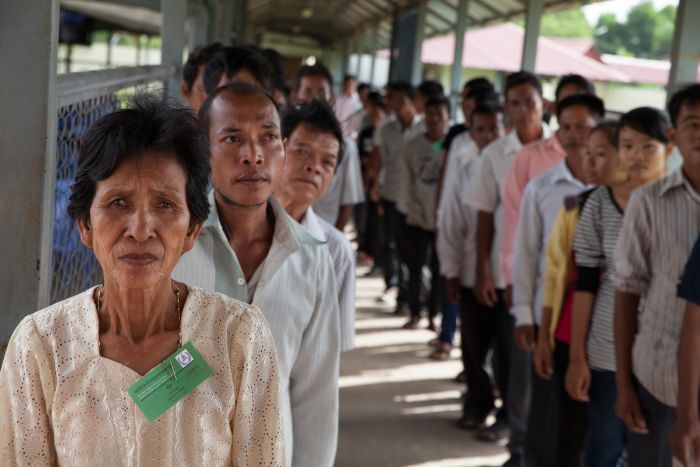Hear from individuals who experienced or witnessed the violence in Bosnia and Herzegovina and its repercussions firsthand.
Christiane Amanpour, Journalist
Christiane Amanpour has covered war zones around the world. Throughout the 1992-95 war in Bosnia, her broadcasts on CNN reported the suffering of Bosnian civilians to international audiences. On April 13, 1993, Amanpour reported on the evacuation of Bosniak civilians who had been wounded during a Bosnian Serb assault on the town of Srebrenica. She was shocked to discover that many of the wounded were children.
The Serb offensive ceased when the United Nations declared Srebrenica a “safe haven” on April 16, 1993. Two years later, however, Bosnian Serb forces launched a new offensive to capture Srebrenica. They killed an estimated 8,000 Bosnian Muslim men and boys, massacres deemed genocide by an international court in 2001.
Eric Dachy, Aid Worker
Dr. Eric Dachy was working in the former Yugoslavia with an international aid organization in 1993 when he joined a United Nations peacekeeping convoy to the town of Srebrenica, then under siege by Bosnian Serb forces. Inside Srebrenica, the Bosniak population had been without electricity, running water, adequate food, and medical supplies for months. Dachy knew that his medical skills and the supplies he was bringing to Bosnian doctors would not matter if the Serbs took the town. When the United Nations declared Srebrenica a “safe haven” on April 16, 1993, largely as a result of the UN convoy's trip, the Serb offensive was halted. Dachy stayed in Srebrenica for three days and shortly thereafter helped establish a permanent international medical presence there.
Ron Haviv, Photojournalist
In April 1992, photojournalist Ron Haviv was granted permission by the Serbian paramilitary leader known as Arkan to join his forces, the Tigers, as they entered the eastern Bosnian town of Bijeljina. Haviv became a witness to some of the first atrocities in the Bosnian war as the Tigers assaulted and killed Bosniak civilians. Despite being told not to take photographs, Haviv managed to document some of what he saw.
Haviv continued to work in Bosnia throughout the war and later in Kosovo. His photographs provide some of the most stunning evidence of crimes from the Balkan wars (1991–1999). His work to expose human rights violations in the Balkans, Latin America, the Middle East, Russia, and Africa—notably in Sudan and Democratic Republic of the Congo—has earned him the reputation as one of today's finest photojournalists.
Nataša Kandić, Human Rights Activist
Nataša Kandić is a Serbia-based human rights advocate who has documented abuses throughout the wars in Croatia, Bosnia, and Kosovo. She has crossed frontlines to document atrocities, provided legal aid to victims, and been a leading figure in establishing the truth of Serbian war crimes. Because of her work, she has faced multiple death threats.
In 2003, a former member of the Skorpions, a Serbian paramilitary group, contacted Kandić. He was willing to testify about atrocities the Skorpions had committed and to offer evidence. A year later, Kandić managed to secure a copy of a home video that the Skorpions made of their participation in executions of Bosniak men and boys after the fall of Srebrenica in 1995. After it was shown on television, the videotape made a significant impact on Serbian public opinion because it presented evidence created by the perpetrators themselves.
Hasan Nuhanović, Survivor
In 1992, Hasan Nuhanović and his family fled the violence in their hometown of Vlasenica but got only as far as Srebrenica. United Nations peacekeepers arrived in Srebrenica in 1993, and Nuhanović found a job with them as a translator. When the Bosnian Serb army attacked Srebrenica in 1995, Nuhanović and his family sought shelter at the UN base with some 30,000 other civilians.
The Dutch UN peacekeepers handed the civilians over to the Bosnian Serbs, who separated men from women and children. Nuhanović was allowed to stay on the base because of his job. He desperately sought permission for his family to remain as well. Nuhanović's parents and brother were forced off the UN base. All three were among the 8,000 Bosniaks killed by the Serbs. Nuhanović has since learned some details about where and how his family was killed, but their remains have not been found.
Dragan Obrenović, Perpetrator
Dragan Obrenović was chief of staff and deputy commander of the 1st Zvornik Infantry Brigade of the Bosnian Serb Army from December 1992 through November 1996. After Srebrenica fell to Bosnian Serb forces in July 1995, Obrenović helped implement the plan to kill Bosniak civilians and prisoners of war. Indicted for his role in the massacres, in 2003 Obrenović pleaded guilty to crimes against humanity before the International Criminal Tribunal for the Former Yugoslavia (ICTY). He is serving a 17-year sentence in a Norwegian prison.
The ICTY has held several trials regarding Srebrenica, including that of Serbian leader Slobodan Milosević who died in custody before his case, which included charges of genocide, was concluded. Bosnian leader Radovan Karadzić, arrested July 21, 2008, is charged with genocide, as is Bosnian Serb General Ratko Mladić, who remains at large.



